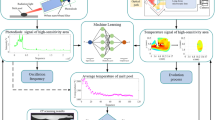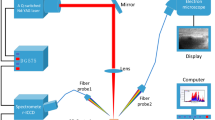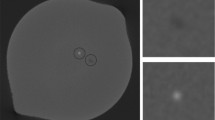Abstract
The directed energy deposition (DED) process is attracting significant attention in high value-added industries, such as automobiles and aviation, because the process can freely manufacture components with complex shapes and directly stack them on metal substrates. However, it has a problem of degradation in reliability and poor reproducibility due to the influence of various parameters present in the process, and various defects are likely to occur inside and outside the product. To solve this problem, a proper data-driven prognostics and health management (PHM) approach is required. Therefore, this study proposes a multi-defect diagnosis algorithm for the DED process based on in situ melt-pool monitoring. First, the DED process monitoring testbed using a CCD camera and a pyrometer was established. The image pre-processing algorithms are developed for the effective extraction of region-of-interest (ROI) areas of the melt-pool and for effective quantification of internal defects, such as pores. Then, critical features of the melt-pool that are closely related to various defects—melting balls, low pores, and high pores—are extracted. Finally, the multi-defect diagnosis algorithm combining several binary classification models is developed, and it is demonstrated that support vector machine (SVM) showed the best performance, with an average accuracy of 92.7%.













Similar content being viewed by others
Data availability
All data generated or analyzed during this study are included in this published article.
Code availability
Not applicable.
References
Guo N, Leu MC (2013) Additive manufacturing: technology, applications and research need. Front Mech Eng 8(3):215–243. https://doi.org/10.1007/s11465-013-0248-8
Wong V, Hernandez A (2012) A review of additive manufacturing. Int Sch Res Notices. https://doi.org/10.5402/2012/208760
Frazier WE (2014) Metal additive manufacturing: a review. J Mater Eng Perform 23:1917–1928. https://doi.org/10.1007/s11665-014-0958-z
Dutta B, Palaniswamy S, Choi J, Song L, Mazumder J (2011) Additive manufacturing by direct metal deposition. Adv Mater Processes 169(5):33–36
Saboori A, Aversa A, Marchese G, Biamino S, Lombardi M, Fino P (2019) Application of directed energy deposition-based additive manufacturing in repair. Appl Sci 9(16):3316. https://doi.org/10.3390/app9163316
Dass A, Moridi A (2019) State of the art in directed energy deposition: from additive manufacturing to materials design. Coatings 9(7):418. https://doi.org/10.3390/coatings9070418
Yang Y, Gong Y, Li C, Wen X, Sun J (2021) Mechanical performance of 316 L stainless steel by hybrid directed energy deposition and thermal milling process. J Mater Process Tech 291:117023. https://doi.org/10.1016/j.jmatprotec.2020.117023
Yang Y, Gong Y, Qu S, Xie H, Cai M, Xu Y (2020) Densification, mechanical behaviors, and machining characteristics of 316L stainless steel in hybrid additive/subtractive manufacturing. Int J Adv Manuf Technol 107:177–189. https://doi.org/10.1007/s00170-020-05033-2
Qu S (2021) Gong Y (2021) Effect of heat treatment on microstructure and mechanical characteristics of 316L stainless steel parts fabricated by hybrid additive and subtractive process. Int J Adv Manuf Technol 117:3465–3475. https://doi.org/10.1007/s00170-021-07786-w
Gong Y, Yang Y, Qu S, Li P, Liang C, Zhang H (2019) Laser energy density dependence of performance in additive/subtractive hybrid manufacturing of 316L stainless steel. Int J Adv Manuf Technol 105:1585–1596. https://doi.org/10.1007/s00170-019-04372-z
Yang Y, Gong Y, Qu S, Rong Y, Sun Y, Cai M (2018) Densification, surface morphology, microstructure and mechanical properties of 316L fabricated by hybrid manufacturing. Int J Adv Manuf Technol 97:2687–2696. https://doi.org/10.1007/s00170-018-2144-1
Yang Y, Gong Y, Qu S, Yin G, Liang C, Li P (2021) Additive and subtractive hybrid manufacturing (ASHM) of 316L stainless steel: single-track specimens, microstructure, and mechanical properties. JOM 73:759–769. https://doi.org/10.1007/s11837-020-04216-2
Kistler NA, Nassar AR, Reutzel EW, Corbin DC, Beese AM (2017) Effect of directed energy deposition processing parameters on laser deposited Inconel® 718: microstructure, fusion zone morphology, and hardness. J Laser Appl 29(2):022005. https://doi.org/10.2351/1.4979702
Shamsaei N, Yadollahi A, Bian L, Thompson SM (2015) An overview of direct laser deposition for additive manufacturing; Part II: Mechanical behavior, process parameter optimization and control. Addit Manuf 8:12–35. https://doi.org/10.1016/j.addma.2015.07.002
Kim JS, Kang BJ, Lee SW (2019) An experimental study on microstructural characteristics and mechanical properties of stainless-steel 316L parts using directed energy deposition (DED) process. J Mech Sci Technol 33(12):5731–5737. https://doi.org/10.1007/s12206-019-1116-1
Nursyifaulkhair D, Park N, Baek ER, Lee JB (2019) Effect of process parameters on the formation of lack of fusion in directed energy deposition of Ti-6Al-4V alloy. J Weld Join 37(6):579–584. https://doi.org/10.5781/JWJ.2019.37.6.7
Fujishima M, Oda Y, Ashida R, Takezawa K, Kondo M (2017) Study on factors for pores and cladding shape in the deposition processes of Inconel 625 by the directed energy deposition (DED) method. CIRP J Manuf Sci Technol 19:200–204. https://doi.org/10.1016/j.cirpj.2017.04.003
Taheri H, Koester LW, Bigelow TA, Faierson EJ, Bond LJ (2019) In situ additive manufacturing process monitoring with an acoustic technique: clustering performance evaluation using K-means algorithm. J Manuf Sci Eng 141(4):041011. https://doi.org/10.1115/1.4042786
Gaja H, Liou F (2017) Defects monitoring of laser metal deposition using acoustic emission sensor. Int J Adv Manuf Technol 90(1):561–574. https://doi.org/10.1007/s00170-016-9366-x
Wang L, Felicelli SD, Craig JE (2007) Thermal modeling and experimental validation in the LENS™ process, In 2007 International Solid Freeform Fabrication Symposium. https://doi.org/10.26153/tsw/7197
Bi G, Gasser A, Wissenbach K, Drenker A, Poprawe R (2006) Investigation on the direct laser metallic powder deposition process via temperature measurement. Appl Surf Sci 253(3):1411–1416. https://doi.org/10.1016/j.apsusc.2006.02.025
Khanzadeh M, Chowdhury S, Tschopp MA, Doude HR, Marufuzzaman M, Bian L (2019) In situ monitoring of melt pool images for porosity prediction in directed energy deposition processes. IISE Trans 51(5):437–455. https://doi.org/10.1080/24725854.2017.1417656
Seifi SH, Tian W, Doude H, Tschopp MA, Bian L (2018) Layer-wise profile monitoring of laser-based additive manufacturing, In 2018 International Solid Freeform Fabrication Symposium. https://doi.org/10.26153/tsw/17014
Montazeri M, Nassar AR, Stutzman CB, Rao P (2019) Heterogeneous sensor-based condition monitoring in directed energy deposition. Addit Manuf 30:100916. https://doi.org/10.1016/j.addma.2019.100916
Sames WJ, List FA, Pannala S, Dehoff RR, Babu SS (2016) The metallurgy and processing science of metal additive manufacturing. Int Mater Rev 61(5):315–360. https://doi.org/10.1080/09506608.2015.1116649
Gibson I, Rosen DW, Stucker B (2015) Additive manufacturing technologies: 3D printing, rapid prototyping, and direct digital manufacturing, 2nd edn. Springer, New York:245–268. https://doi.org/10.1007/978-1-4939-2113-3
Dilip JJS, Zhang S, Teng C, Zeng K, Robinson C, Pal D, Stucker B (2017) Influence of processing parameters on the evolution of melt pool, porosity, and microstructures in Ti-6Al-4V alloy parts fabricated by selective laser melting. Prog Addit Manuf 2(3):157–167. https://doi.org/10.1007/s40964-017-0030-2
Kim JS (2020) Comprehensive characterization of directed energy deposition (DED) process, PhD thiesis, Sungkyunkwan University
Park JM, Jeon JM, Kim JG, Seong Y, Park SH, Kim HS (2018) Effect of porosity on mechanical anisotropy of 316L austenitic stainless steel additively manufactured by selective laser melting. J Korean Powder Metall Inst 25(6):475–481. https://doi.org/10.4150/KPMI.2018.25.6.475
Gu D, Shen Y (2009) Balling phenomena in direct laser sintering of stainless steel powder: metallurgical mechanisms and control methods. Mater Des 30(8):2903–2910. https://doi.org/10.1016/j.matdes.2009.01.013
Vilaro T, Colin C, Bartout JD (2011) As-fabricated and heat-treated microstructures of the Ti-6Al-4V alloy processed by selective laser melting. Metall and Mater Trans A 42(10):3190–3199. https://doi.org/10.1007/s11661-011-0731-y
Hofman JT, Pathiraj B, Van Dijk J, De Lange DF, Meijer J (2012) A camera based feedback control strategy for the laser cladding process. J Mater Process Technol 212(11):2455–2462. https://doi.org/10.1016/j.jmatprotec.2012.06.027
Funding
This research was supported by the Ministry of Science, ICT (MSIT), Korea, under the High-Potential Individuals Global Training Program (2021–0-01550), supervised by the Institute for Information & Communications Technology Planning & Evaluation (IITP), and the National Research Foundation of Korea (NRF) grant (2022R1A2C3012900), funded by the Korea government (MSIT).
Author information
Authors and Affiliations
Contributions
HS, experiments, analysis, writing—original draft; JL, experiments, methodology, and modeling; S-KC, supervision; SWL, conceptualization, supervision, and writing (review and editing).
Corresponding author
Ethics declarations
Ethics approval
Not applicable.
Consent to participate
The authors declare that all authors have read the manuscript and approved the submission of this manuscript to The International Journal of Advanced Manufacturing Technology.
Consent for publication
The authors declare that all authors agree to sign the transfer of copyright to the publisher or publish this article upon acceptance.
Conflict of interest
The authors declare no competing interests.
Additional information
Publisher's note
Springer Nature remains neutral with regard to jurisdictional claims in published maps and institutional affiliations.
Hyewon Shin and Jimin Lee are co-first authors.
Rights and permissions
Springer Nature or its licensor (e.g. a society or other partner) holds exclusive rights to this article under a publishing agreement with the author(s) or other rightsholder(s); author self-archiving of the accepted manuscript version of this article is solely governed by the terms of such publishing agreement and applicable law.
About this article
Cite this article
Shin, H., Lee, J., Choi, SK. et al. Development of multi-defect diagnosis algorithm for the directed energy deposition (DED) process with in situ melt-pool monitoring. Int J Adv Manuf Technol 125, 357–368 (2023). https://doi.org/10.1007/s00170-022-10711-4
Received:
Accepted:
Published:
Issue Date:
DOI: https://doi.org/10.1007/s00170-022-10711-4




